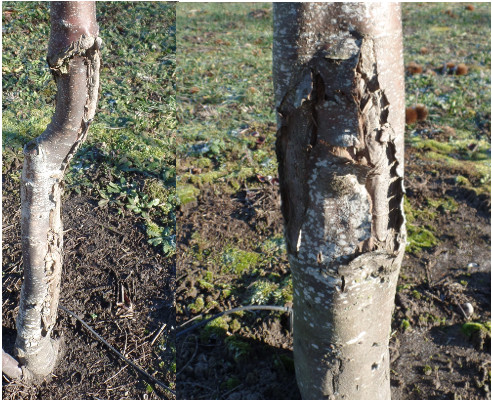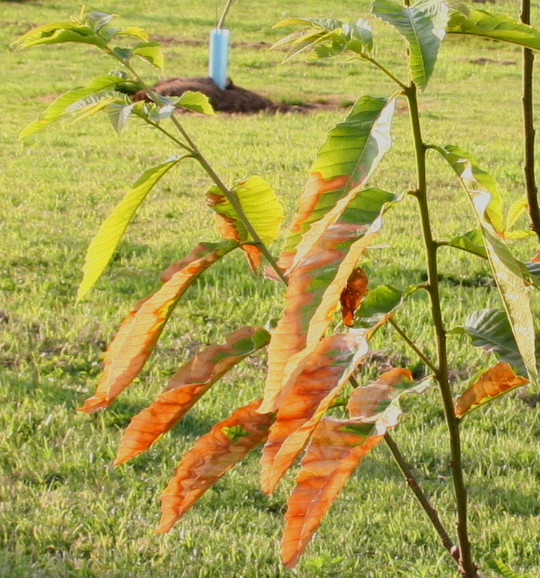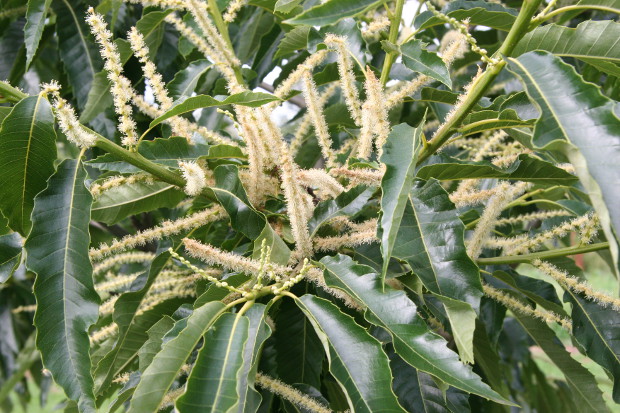| |
Nitrogen (N) is one of the three main ingredient components in fertilizers used in the production of agricultural products such as fruits, vegetables, grains, and nuts. Depending on environmental conditions and the crop being produced, the need for N is highly varied, so much so that even the scientists argue about what is the right amount of N to apply to a crop. For chestnut growers, the knowledge base is very limited on the proper application of N.
Before considering possible solutions to application rates for N, we need to look at why we would consider applying N to a chestnut orchard and why we should not apply N. First, applying lots of N in a chestnut orchard, amounts of greater than 0.2 lbs per inch of caliper of tree trunk base, is a waste of money and can expose the chestnut trees to winter freeze damage. Starting with 0 N per tree up to 0.2 lbs per inch of caliper of tree effects the production of chestnuts, with the more N applied the fewer chestnuts produced. The more N applied the faster the chestnut trees grow. So that’s the basics of N applied to a chestnut orchard.

Here is a picture of two chestnut trees with freeze damage. The freeze damage
in this case was a result of applying urea in late Augest or September. The
late application of nitrogen gave the chestnut trees a late boost for gowth but
left the cambium layer between the outer bark and the wood of the chestnut tree
susceptible to a freeze that came during the winter when tempetures dropped
below 25 degrees F.
If these trees were small trees with a diameter at the base of less than one
inch, then the trees would have died at the ground level. The root system of
the trees would likely survive unless the cold caused the soil temperatures to
drop below 25 degrees F.
To prevent this from happening to your chestnut trees,
"Don't
apply N once your chestnut trees have started to bloom."
Now for the complications of applying N to a chestnut orchard. Soil science helps us with knowing the soil particle size has a direct effect on holding on to N and keeping the N available for utilization by the trees. The larger the particle size the less N holding capacity the soil has. Clay soils have very small particles and as a result, clay has a very high N holding capacity. The less holding capacity of a soil, the more often N has to be applied but at a much lower application rate. So the question arises, “How often should I apply N in my chestnut orchard?” The answer is at least twice a year, if N is needed at all. The first application is performed when the first leaves of the spring are nearly full size, about 3 weeks after the buds start extending growth in the spring.

Phytopthora cinnamomi and phytopthora ramorum are plant pathogens that infects
chestnut trees. P. ramorum is present in Northern California and Southern
Oregon. The USDA has placed plant quarantines on chestnut and oak trees from
these areas to prevent its further spread.
P. cinnamomi is very wide spread and found just about everywhere. The picture
to the right is of a chestnut tree declining and will eventually die from the
infection. There are three things a chestnut orchardist can do to keep P.
cinnamomi from infecting their chestnut trees. The first thing is location,
by location we mean don't plant chestnut trees where phytopthora is present in
the soils and do not plant chestnut trees in heavy/clay soils.
The next thing an orchardist can do is to wait until the soil tempertures are
above 60 degrees F in the spring before applying any N to the soil. Phytopthora
is not normally present in arid conditions. N is not washed out of soils in
arid locations. So in wet cool location where phytopthora is commonly found,
"Don't apply N early in the spring. Wait until the soil has warmed up
and the chestnut tree has extended its first leaves in the spring."
The second application should be when the chestnut trees start blooming. Later than the bloom time can leave the chestnut trees vulnerable to winter freeze damage.
The next complication of applying N to a chestnut orchard is associated with phytophthora. Raspberries are also vulnerable to phytophthora. In raspberry fields, growers have found that applying N early in the spring before the soil warms up, phytophthora problems increase causing cane death. Chestnut trees can suffer the same fate. Consider applying N only after the soil temperature at 8” reached 60 F in the spring.
The best performing chestnut orchards, gauged by the pounds per acre, are well managed with annual soil and foliar sample analysis performed to evaluate the nutrient uptake into the chestnut trees. In semi arid locations, soils receiving less than 15” of rain per year, N has a high persistence from year to year. In location with more than 20” of rain a year, depending on the distribution of the rain, N gets washed out of the soil. In the wet parts of the Pacific Northwest, by the time spring rolls around there is almost no N left in the soil. Healthy chestnut trees have a excellent storage capacity to hold nutrient from the end of the last growing season to well into the new growing season. This is yet another reason chestnut orchardists should not rush out at bud break and dump N into the orchard. All the newly applied N might get washed out of the soil before the chestnut trees could use the N.
By now the chestnut orchardist should be scratching their head wonder how to make the application of N in the orchard a simpler problem. There is no simple solution. If you understand how to use calculus, the problem could be solvable. To solve the problem we have to look at the chestnut grower’s goals for their orchard. For all chestnut orchardists the goal is to produce the maximum pounds per acre. A survey of some chestnut growers in 2015 about their orchards performance at producing chestnuts per acre gave number from 200 to over 4000 pounds to the acre. This high variance is associated with the age of the trees in the orchard, the spacing of the trees, orchard management practices and the cultivars in the orchard. The orchards producing 4000 pounds to the acre have Colossal chestnut trees producing the chestnuts. Consider this example:
An orchard of Colossal chestnut trees planted at 75 grafted trees per acre and is 12 years old with a nearly complete canopy covering the orchard produces 65 pounds of chestnuts per tree. This works out to be over 4000 pounds per acre. This has been accomplished by several growers in the western states of California, Oregon, and Washington. It can be done, is being done, and is achievable. Remember, the canopy has to be nearly complete to get this performance.
Chestnut tree growth should also be one of the grower’s goals for their
orchards. When the trees are young, the goal would be to have the chestnut
trees grow fast to get close to a full canopy as fast as possible. Here is
another grower’s example where the goal was to grow the chestnut trees as fast
as possible:
An orchard of chestnut trees planted in the winter with grafted trees between 24 - 36 inches tall. For the first 8 years the orchard is provided N at a rate of 0.2 lbs per inch of tree caliper. By the end of the 6th year the canopy is nearly complete. Normally, a chestnut orchard would take 12 or more years to complete the canopy cover. This orchard typically has 4 - 6 foot of new growth a year for the first 4 years for the typical European hybrid chestnut trees such as Colossal, Bouche de Betizac, Prococe Migoule, Basalta #2 & 3, and Marsol.

This is an example of healthy chestnut tree new growth during the bloom period.
These examples are incredible. They build up the desire for “I want this performance from my chestnut orchard”. For these performance to be achieved the chestnut orchardist has to make the decision of either growing their orchard fast or producing high yields of nut production because the higher the amount of N applied to the orchard the lower the nut production.
To find the best possible performance bringing the best economic return to the orchardist, assuming the cost of production per pound is constant, a simple math model can be applied.
Pm = Maximum nut production in lbs to the acre
N = Nitrogen application rate 0.0 - 0.2 in lbs per tree caliper
Cp = Canopy percent complete 0 - 100%
Pa = Actual/forecasted production of pounds to the acre
Ncfg = Nitrogen coefficient for applying N to a chestnut orchard for growth
Ncfp = Nitrogen coefficient for applying N to a chestnut orchard for nut production
Starting with the simple example of using the canopy coverage to forecast production, the math looks like this
Pm = 4000
Cp = 25 canopy is 25% complete
Pm/Cp = Pa; or 4000 * .25 = 1000 pounds
Putting N into the equation we find:
Pa = 4000
Cp = 25 canopy is 25% complete
N = 0.2 lbs per inch of tree caliper
Ncfp = 1.5
Pm/Cp*(N/1.5) = Pa; or 4000 * .25 (0.2/1.5) = 133.3 pounds to the acre
Really! If I apply N at a rate to encourage the maximum growth my harvest drops that much. In the above example, the answer would be yes. The Ncf value is an estimated value based on one orchardist’s experience, not an actual scientific study. Now we should take this to the next step, achieving good growth of the trees and good nut production. If it takes 6 years to get near 100% canopy coverage, then we can express this rate as:
100/Gy * Y = Cp; where the 100 is the percent of canopy coverage, Gy is the number of years to get to the 100 percent coverage, and Y is the number of years that have passed since the orchard was planted.
For example, at the end of the 4th growing season the canopy calculation would look like this if N is applied at 0.2 lbs per inch of caliper:
100/(6 * 4) = 66.7% canopy coverage
Now the N is applied to the canopy coverage example:
100 / (Gy * N Ncfg) * Y = Cp; or 100 / (12 * (0.2 / 0.4)) * 4 = 66.7%
The Ncfp and the Ncfg are not the same numbers. These numbers are a sort of fudge factors to make the equations align to the data set with the functional model. The coefficient numbers are different for different growers because of cultivars chosen, tree spacing, nutrients availability, any many other environmental differences. In general, these fudge factors are a good place to start.
The data set was obtained from logs from a grower establishing a chestnut orchard using Colossals as the primary producer. Other cultivars respond slightly differently to the availability of N in the orchard. The growth response to N is similar with most chestnut cultivars. The reduced nut production can vary a lot. For example Marigoule and Basalta #3 both produce full crops of nuts with high levels of N present in the soil. The full crop is likely going to be a lot of small nuts as compared to Colossal which produces fewer nuts but very large nuts with high levels of N in the soil.
How is a solution found to guide a chestnut orchardist to have enough chestnut production to pay the bills and still grow the orchard canopy quickly? Using the above models for nut production and canopy growth, the models can be brought together to solve how much N to apply. The first step is to choose how much production is needed to pay the bills. It is important to keep the goals in production units such as percent of canopy or pounds of nuts to the acre. This is because the price of nuts change and the cost to maintain the orchard changes with time. The cost of the N is a very minor expense so it can be left out of the equations. A simple place to start is to assume the cost to maintain an orchard is 200 lbs of nuts to the acre.
The most important points in this article is that applying N to a chestnut
orchard can be very beneficial and it can provide the catalyst for doing a lot
of harm and even death to the chestnut trees.
Point #1 - Never apply more than 0.2 lbs of N per inch of diameter to chestnut
trees
Point #2 - The more N applied to the chestnut tree, the more new growth (within
limits)
Point #3 - The more N applied to the chestnut tree, the lower the production of
chestnuts = fewer chestnuts at harvest time
Point #4 - It take N to build the canopy through new growth. A complete canopy
cover is required to acheive full production from a chestnut orchard.
Point #5 - Finding the balance between chestnut production and increasing the
percentage of conopy coverage will take many years. Choose either chestnut
production or conopy production in the early years of establishing a chestnut
orchard.
|



